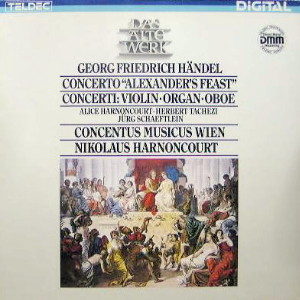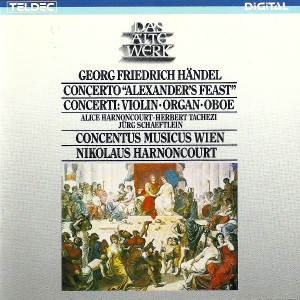 |
1 LP -
6.43050 AZ - (p) 1985
|
 |
| 1 CD -
8.43050 ZK - (p) 1985 |
|
| Georg Friedrich
Händel (1685-1759) |
|
|
|
|
|
|
|
Concerto B-dur, HWV 301
|
|
7' 11" |
A1 |
| für Oboe, Streicher und Basso
Continuo |
|
|
|
| - Adagio |
1' 48" |
|
|
- Allegro
|
1' 44" |
|
|
| - Siciliano, Largo |
2' 13" |
|
|
| - Allegro |
1' 21" |
|
|
| Sonata à 5 B-dur, HWV 288 |
|
8' 07" |
A2 |
| für Violino Solo, Streicher und
Basso Continuo |
|
|
|
| - Andante |
3' 30" |
|
|
| - Adagio |
1' 24" |
|
|
| - Allegro |
3' 09" |
|
|
| Concerto B-dur, HWV 302 |
|
7' 55" |
A3 |
| für Oboe, Streicher und Basso
Continuo |
|
|
|
| - Vivace |
2 01" |
|
|
- Fuga, Allegro
|
1' 50"
|
|
|
| - Andante |
1' 49" |
|
|
| - Allegro |
2' 09" |
|
|
| Concerto G-dur |
|
13' 21" |
B1 |
| per due Violini Concertini e
Violoncello, 2 Hautb., 2 Violini ripieno,
Viola e Basso "The celebrated Concerto in
Alexanders Feast" |
|
|
|
| - Allegro |
3' 37" |
|
|
| - Largo |
1' 45" |
|
|
| - Allegro |
3' 52" |
|
|
| - Andante, non presto |
4' 01" |
|
|
| Concerto d-moll, HWV 305
(304?) |
|
13' 15" |
B2 |
| für Orgel solo und Streicher |
|
|
|
| - Andante |
5' 30" |
|
|
| - Adagio, Organo ad libitum,
e poi una Fuga Allegro, ad libitum |
3' 22" |
|
|
| - Allegro |
4' 21" |
|
|
|
|
|
|
CONCENTUS MUSICUS
WIEN (mit
Originalinstrumenten)
|
|
| -
Jürg Schaeftlein, Oboe (301, 302,
Alexander) |
-
Peter Schoberwalter, Violine |
|
| -
Valerie Darke, Oboe (Alexander) |
-
Kurt Theiner, Viola (301,
Alexander, 305) |
|
| -
Milan Turković, Fagott
(Alexander) |
-
Josef de Sordi, Viola (288, 302) |
|
| -
Alice Harnoncourt, Violine |
-
Nikolaus Harnoncourt, Violoncello
(301) |
|
| - Anita Mitterer, Violine
(302, Alexander, 305) |
-
Rudolf Leopold, Violoncello (288,
Alexander) |
|
| -
Erich Höbarth, Violine (301, 288,
Alexander) |
-
Herwig Tachezi, Violoncello
(302, 305) |
|
-
Andrea Bischof, Violine
|
-
Mark Peters, Violoncello (Alexander) |
|
| -
Walter Pfeiffer, Violine (Alexander) |
-
Eduard Hruza, Violone
|
|
-
Karl Höffinger, Violine
|
-
Herbert Tachezi, Orgel
(301, 302, Alexander, 305),
Orgel/Cembalo (288) |
|
| -
Helmut Mitter, Violine |
-
Gordon Murray, Cembalo
(Alexander) |
|
|
|
| Nikolaus
Harnoncourt, Leitung |
|
|
|
Luogo
e data di registrazione
|
Casino Zögernitz,
Vienna (Austria) - dicembre 1984 &
gennaio 1985
|
|
Registrazione
live / studio
|
| studio |
Producer
/ Engineer
|
-
|
Prima Edizione CD
|
Teldec
"Das Alte Werk" - 8.43050 ZK - (1 cd) -
50' 33" - (p) 1985 - DDD
|
Prima
Edizione LP
|
Teldec "Das Alte
Werk" - 6.43050 AZ - (1
lp) - 50'
33"
- (p) 1985 - Digital
|
|
|
Notes
|
Johann
Mattheson, who knew Handel from thc
cornposer's time in
Hamburg, 1703-1706, wrote about him in
his famous lexicon “Grundlage einer
Ehrenpforte" (1740): “He was a strong
performer on the organ, stronger than
Kuhnau, in fugues and
counterpoints, an exceptional
improviser; but he knew very little
about melody until he came to the
Hamburg opera.” In Mattheson’s
character sketch, which places
Handel’s talents as an organist above
those of Kuhnau, then Thomaskantor at
Leipzig, one is struck by the comment
that Handel’s melodic skills were only
moulded through his contact with
opera, an element reflected in his
instrumental concertos, which are
sparse both in number and in variety
ofscoring. In 1719
Handel began to build up an opera in
London, but in the long term he was
unable to survive the hard struggle
ofcommercial and artistic rivalry,
and thus turned to the
oratorio in the 1730s, For the
performances of these
works Handel once again bore sole
responsibility, and between the
different parts of the oratorios he
played instrumental compositions: The
important organ concertos were written
for this purpose, and for the
performance of the rnasterly
“Alexander`s Feast” in 1736 he comeposed
the concerto which has since borne the
name of the oratorio, and has always
been one of`Handel’s best-loved
conccrtos.
Handel’s preoccupation with thoroughly
virtuoso vocal parts influenced his
emphatically melodic style; prominent
instrumental parts in oratorios and
operas support the vocal lines and
contribute to the realisation of a
superior musical idea. Handel's
soloistic instrumental music
corresponds to the
melodic ideal developed in the vocal
sphere, and he proceeded equally
freely in the adoption and
modification of instrumental forms.
Thus the early Violin Concerto HWV
288, probably originally composed as a
chamber piece with oboe instead of
violin, cannot be compared with an
Italian concerto. The andante consists
of song-like triad figures, the same
basis idea which Handel used later in
“Belshazzar” again, and
only in the final movement is the
Italian concerto style heard: pure
Vivaldi, daring and virtuosic. The
central movement is a short adagio,
more of a transition passage than a
movement in its own right.
The so-called Oboe Concerto no. 4 is
likewise not a solo concerto in the
normal sense of the word, and it is
not only the four movements that
brings it into the vicinity of the
concerto grosso. The first movement
has two violins in the solo rôle,
the oboe being employed in the tutti
to reinforce and add colour to the
violin sound. The viola part seems to
be lost and has been completed by
Herbert Tachezi. The
second movement, a fugue, and the
finale do without solo instruments
altogether; only the andante makes use
of the oboe’s solo cantabile. This
movement may well have taken
Albinoni’s famous oboe concerto as its
model. A concerto of this kind is not
uncommon in Handel, but it would have
been inconceivable for the Italian
composers.
In the case ofthe
concerto grosso "Alexander’s Feast",
it is only the four-mouvement plan and
the fact that the solo cello is silent
in the final movement that prevent one
from classifying it as a group
concerto. In this
type of concerto, there are several
solo instruments instead of one -
here two violins and cello -, which
are treated as a solo group and in
this recording are put in the far
background. In no other concerto
grosso of Handel's
is there such regular alternation
between tutti and solo, in no other
concerto grosso does the virtuoso and
light, gay yet noble playing of the
soli dominate as in this work.
After the brilliant opening movement
and the vocally rounded largo, the
second allegro is a rondo of a special
kind: the solo group states the
theme,which is then taken up by the
tutti. In the course of the movement
the rondo theme always appears in the
tutti, with repeated changes of key
and with different orchestral parts
leading, while the soloists take
responsibility for the intervening
pieces. The alternation between soli
and tutti thus created is supplemented
by the instrumentation and by changes
of key from one ritornello to the
next. As so often in his concerti
grossi, here too Handel follows with a
movement that is out of the ordinary.
The unusual tempo marking "Andante non
presto" indicates
that the Lombardic rhythm should not
congeal into a grace-note, into mere
decoration. In rondo style Handel
composes different dynamic stages with
two solo violins, strings and
thorough-bass instrumentationally.
“Alexander’s Feast or the Might of
Music" is an Ode to St Cecilia in
mythological dress, a homage to music.
The concerto grosso is not, it is
true, motivistically connected with
the Cecilia tradition, but the
occasion of the
composition may have made at least a
notional contribution to this unusual
work.
Handel’s organ concertos are not only
unique among Baroque concertos
tor their solo instrument: they are
also unconventional in terms of
form. Thus some of the sixteen
concertos have more than three
movements, while others, such as the
one recorded here, contain only two
fully composed movements; in still
others, a solo violin or solo cello is
added to the organ. At the actual
performances, given between sections
ot his oratorios, Handel had only a
small instrument without a
pedal-board, a positive organ, at his
disposal. The composition is therefore
tailored for performance on this kind
of instrument, and sounds melodic and
clear. Embellishments are noted
sometimes only at the beginning of a
movement, sometimes not at all; the
intetpreter then has to supply them
himself. Individual
movements are frequently not written
out, since Handel used to improvise
them as an unaccompanied solo. Thus in
this concerto, even early editions
contain the direction after the first
movement: "Adagio: Organo
adagio ad libitum, e
poi una Fuga allegro ad libitum, poi
segue 9/8" (An organ
adagio of the players
choice, then a fugue allegro
ad libitum, then follows 9/8, i.e. the
composed allegro). And in the first
movement, too, there are passages to
be filled in ex tempore by the
organist. Mattheson`s description of
handel quoted above is thus
consummated in turn by the organ concertos,
which unite the great organist and
improviser with the master of
melody.
Gerhard Schuhmacher
Translation:
Clive
Williams
|
|
Nikolaus
Harnoncourt (1929-2016)
|

|

|
|